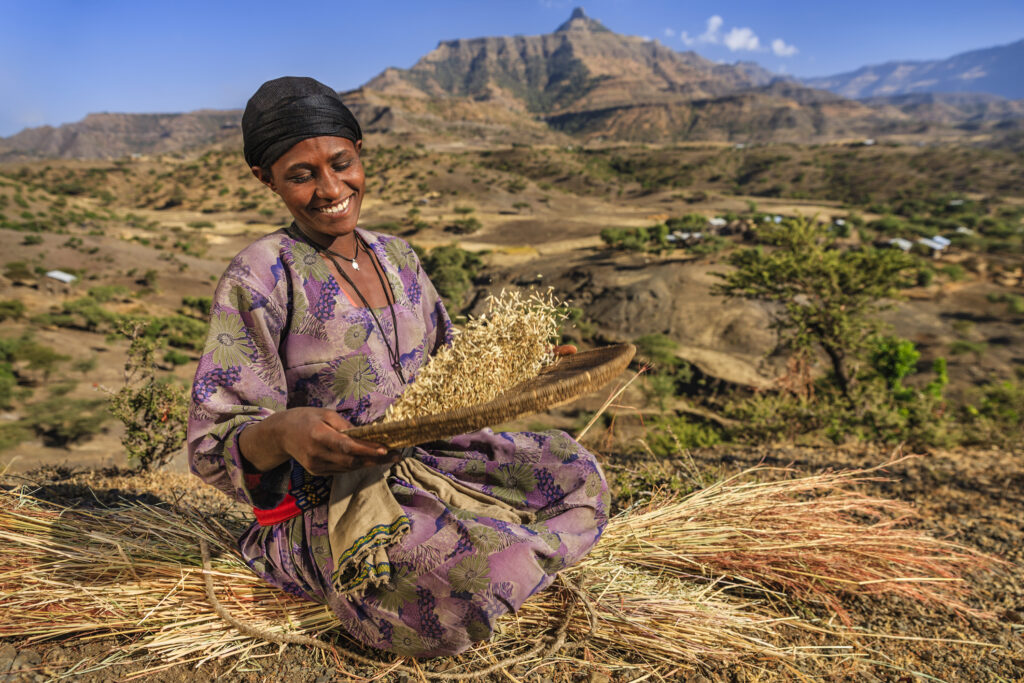Speaking at the international conference A Sustainable Food Future 2018, hosted by Chatham House, SEI Executive Director Måns Nilsson made the case for innovation-driven food systems and described how they can contribute across the 2030 Agenda for Sustainable Development.

African woman is sifting sorghum in Ethiopia, Africa. Sorghum is the fifth-most important cereal crop grown in the world. Photo: hadynyah / Getty Images.
Today, food systems in Africa are under pressure from several global factors. First, climate change is affecting food production; causing droughts and reducing yields. Second, low productivity due to damaged crops and limited access to agricultural value chains, are causing difficulties for rural livelihoods and poverty. Third, rising populations are increasing food demand. Fourth, the growth of the middle class is changing diets, resulting in greater demand for meat and dairy.
“When tackling these challenges, investing in innovation is necessary, especially in low-income countries with high-population growth,” said Nilsson.
Drawing on his experience as part of the BioInnovate Africa advisory committee, he explained how innovation-driven food systems can contribute to multiple SDG targets throughout the 2030 Agenda. Innovations can:
BioInnovate Africa is currently the largest effort to strengthen bioscience innovation in Africa, focusing on adding value to food production and agricultural waste.
At the conference, Måns Nilsson presented case studies from ongoing BioInnovate programmes in eastern Africa that show how novel technologies, innovations and innovation systems that can make significant contributions to a sustainable food future in Africa.
In the first case study, a team in Uganda, Kenya and Rwanda have created a mobile app used to trade and monitor distribution of disease-free sweet potato vines, from tissue culture labs to the farmers’ fields. They use a portable diagnostic device to detect infected plants along the supply chain.
Sweet potato is a staple food for 100 million people in sub-Saharan Africa. However, farmers’ preferred cultivars are susceptible to viral diseases, which can damage whole crops in infected farms. Maintaining a stable supply of high-yield, genetically pure, pest- and disease-free sweet potato vines for planting is vital for improved productivity and food security.
Sorghum and millet are so-called orphan crops – local crops that are not internationally traded and tend to be overlooked in agricultural research. They are grown by more than 300 million farmers in sub-Saharan Africa.
Sorghum and millet offer great potential for improved food supply and socio-economic development in marginalized communities. In particular, both can be used to produce gluten-free, mineral-enriched food products that provide health benefits for people with special dietary needs, potentially adding value and more stable incomes for smallholder farmers. They are also resilient to the effects of climate change.
The second case study Nilsson presented is attempting to create new markets for value-added products based on these crops, through business model development, business incubation, market and supply chain research, and innovative products and processes.
Bioscience innovations have significant potential to contribute to sustainable development and economic growth in eastern Africa. SEI’s research has identified barriers and enabling conditions for moving bio-innovations from the laboratory to the market in the region.
Research into bioscience innovation in Ethiopia, Kenya, Rwanda, Tanzania and Uganda is described in an SEI working paper, Supporting Bioscience Innovation in Eastern Africa. Policy recommendations on how public policy can strengthen the conditions for bioscience innovation are presented in the study, which was produced during the first phase of BioInnovate.
Design and development by Soapbox.